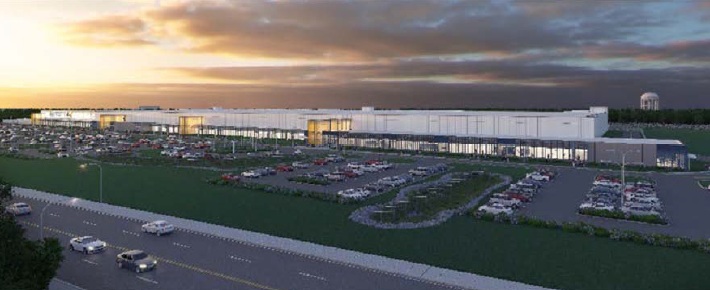
In February, 2016 SolarCity, the largest residential solar PV installer in the US said in its fourth quarter 2015 earnings call that its ambitious 1GW Buffalo Riverbend manufacturing facility had been impacted by longer than expected equipment lead times, pushing some equipment installs into the second-half of 2016.
However, much of the equipment set to produce its hybrid heterojunction cell and module technology from its acquisition of start-up Silevo remained a mystery.
Unlock unlimited access for 12 whole months of distinctive global analysis
Photovoltaics International is now included.
- Regular insight and analysis of the industry’s biggest developments
- In-depth interviews with the industry’s leading figures
- Unlimited digital access to the PV Tech Power journal catalogue
- Unlimited digital access to the Photovoltaics International journal catalogue
- Access to more than 1,000 technical papers
- Discounts on Solar Media’s portfolio of events, in-person and virtual
We previously noted in October, 2015 that silence over what could have been around a US$400 million to US$450 million earnings bonanza for hard-hit PV equipment suppliers continued, despite the Buffalo facility nearing construction completion.
Ever since the 1GW production plans were announced back in July, 2014 speculation has remained over the tool selection. Indeed, no conference or exhibition that PV Tech had attended since that time, did the subject of tool selection not arise with industry people.
In contrast to the regular intensity of PR from SolarCity, the company has chosen the stealth mode over the equipment orders. However, what became known was that a number of major equipment orders had been placed in early 2015 with suppliers based in Japan, Taiwan and Germany.
PV Tech had previously highlighted that turnkey back-end module assembly equipment supplier NPC Group, based in Japan had been Silevo’s vender of choice at its 100MW pilot line that was relocated from China to Silicon Valley and indeed, NPC is believed to be the vender of choice for the Buffalo fab, according to analysis of its financial filings.
However, the biggest interest was in the front-end processing equipment as Silevo’s hybrid-heterojunction cell architecture relies heavily on thin-film processes such as PVD (Physical Vapour Deposition) and copper electroplating, all advanced next generation technologies that enable high-efficiencies and low cost production. It is also where the majority of capital expenditure would be allocated.
One of the challenges in identifying the suppliers was the dependence on thin-film processes as the majority of suppliers have little exposure to the PV industry and primarily service the FPD (Flat Panel Display) and semiconductor industries.
A process of elimination only got us so far in the search, though any key involvement by the PV industry’s leading PECVD suppliers to p-type lines was ruled out based on lack of tool orders coming from the US.
According to PV Tech’s analysis, German-based equipment specialist Singulus Technologies is one of the key front-end suppliers to the Buffalo fab, possibly supplying its modular SILEX II wet processing batch system for n-type monocrystalline wafer texturing and its HISTARIS inline sputtering system for anti-reflection, barrier, buffer and precursor layers.
A stumbling block did exist in identifying the a-Si (PECVD) deposition tool supplier, until by accident we stumbled across Taiwan-based firm, Archers Systems.
In a February, 2016 press release, believed to be related to a new order from Taiwan-based solar cell producer, Neo Solar Power (NSP), Archers makes clear reference to the “US largest rooftop solar PV provider” and its “1GW HJT solar cell production capacity”, which noted that it had “successfully delivered and received the final acceptance for the equipment ordered by this client in 2015”.
There still remains some uncertainty over whether we have got these supplier selections right as on purpose they were not contacted as they would surely be under NDA agreements. There also remains some uncertainty in regards to some other tool selections but the picture is emerging.
Clearly, some of the key pilot line suppliers to Silevo have benefited from follow-on volume production orders, which although comes across as an obvious move, it highlights that processes from what looks increasingly like a successful pilot line project to the fab should have a higher repeatability factor and a better chance of a successful production ramp.
Ramp schedule
Since the Buffalo fab was announced we were of the opinion that SolarCity/Silevo would be totally mad to try and ramp all 1GW of production lines at once.
Instead, the logical assumption was that the plant would be ramped in phases, such as 200MW to 500MW sized ramps. Only recently, key information garnered indicated that the company was indeed attempting to ramp all 1GW of production lines at once.
The news back in February, 2016 that longer than expected equipment lead times than originally expected would impact the overall production ramp schedules, coupled to a knock-on effect of allowing a delay in the purchase of an unidentified amount of the equipment until some time in 2017, could have been a bit of a red herring.
Plans to start ramping production in the second-half of 2016 look highly likely, based on recent findings. Should this prove real, SolarCity and Silevo as well as New York state and the State University of New York's College of Nanoscale Science and Engineering, which would own the buildings and equipment, would garner significant kudos and allay significant concerns over the planned execution.
Update
An anonymous source backed with credentials informed us that we may have got the involvement of Singulus wrong. Countless hours of unpaid research could be up in smoke but we are still having fun trying to put together such a puzzle.
However, the German involvement still exists but we are keeping that aspect to ourselves at the moment.







